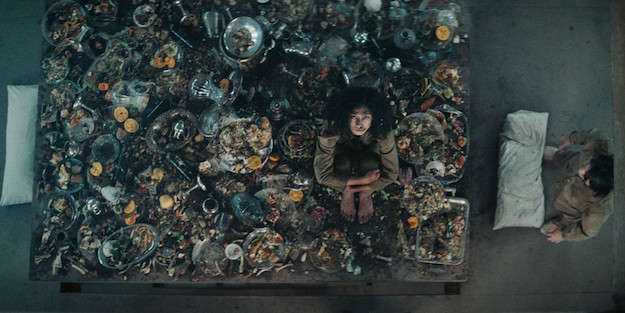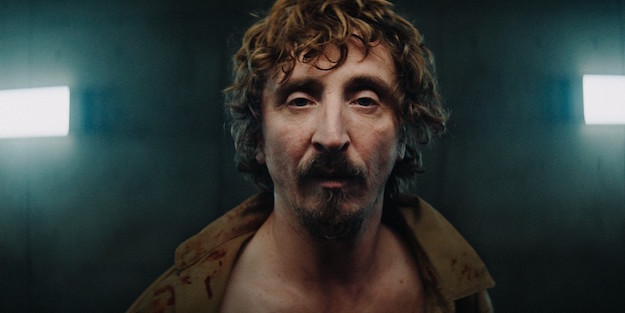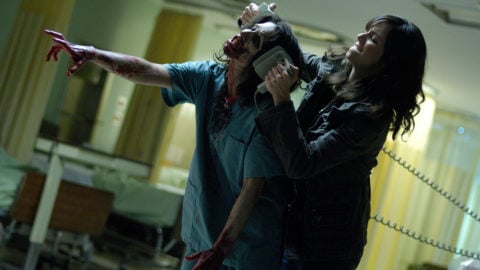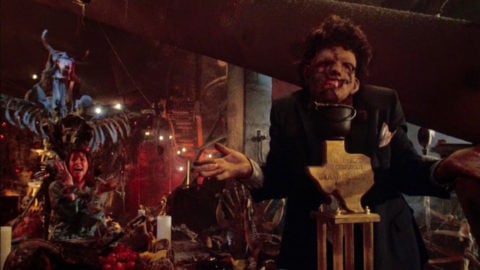Film of the Week: The Platform

At a time when every other film is potentially open to interpretation as being somehow obscurely about the effects of the coronavirus pandemic, The Platform has a better claim than most. Currently showing on Netflix, this dystopian horror film from Spain is about the agony of being confined in a small space with someone you’d rather not be with. Directed by Basque filmmaker Galder Gaztelu-Urrutia and written by David Desola and Pedro Rivero, The Platform is an ingenious and economical high-concept piece that uses its simple premise to generate some pithy, and fairly disquieting, sociopolitical resonances.
Here’s the gist: a man (Iván Massagué) wakes up in a concrete cell equipped with a bunk at either side of the room, and a rectangular hole in the floor. There are many identical cells above, many more below. His cellmate, an elderly man named Trimagasi (Zorion Eguileor)—names, some obscurely food-related, have been assigned to inmates by “the Administration”—explains to the newcomer, Goreng, how things work. They’re in “the Hole”—the meaning of the film’s Spanish title, El Hoyo—and they’ll be together for some time. Every day, a platform will descend from the ceiling laden with food—or rather, the leftovers of the food that has already been feasted on by the people above. Internees have a short time to eat what they can before their own leftovers descend to feed those below them—and so on, with each pair of prisoners in turn left with less and less to eat. At the moment, he and Goreng are lucky, says Trimagasi: Level 48 (the numbers are imprinted in the wall of each cell) isn’t a bad floor to be on. But every month, the prisoners are moved to a different level, more or less randomly: you could be high up, with plenty to eat, or down in the lower depths (and who knows just how many levels there are?) and forced to survive any way you can, if you can.
Starting from this basic concept, The Platform works like a game to which more rules and deviations are added all the time, although there’s at least an impression of fundamental coherence to the whole thing. Prisoners can bring one item with them: Goreng has chosen a copy of Don Quixote, while Trimagasi, ominously, has brought a super-sharp knife (and his story about how the “Samurai Plus” landed him in the Hole is one of the film’s most relishably bleak touches). You can’t hold on to food to eat later—if you do, the heat in your cell rises or falls intolerably—so you just have to gobble. The struggle to survive is such that there’s bound to be violence; it’s hardly a spoiler to reveal that there’s cannibalism along the way, although if you’re at all sensitive about table etiquette, be warned that the bloody sequences aren’t nearly the most stomach-turning content here.

There’s also a wild card thrown into the equation: a silent, very dangerous young woman named Miharu (Alexandra Masangkay) who turns up regularly, riding the platform through the levels, supposedly in search of her lost child. At one point, she unexpectedly turns up to intervene in Goreng’s fate: as close a literal interpretation of a deus ex machina as you can get. As for Goreng, it’s revealed early on that he has actually volunteered to spend a month in the prison, because he wants to give up smoking and read Cervantes, and stands to come out of it with a diploma. The official, Imoguiri, who has evaluated him for his stay will herself turn up as his cellmate, accompanied by a dachshund called Rameses II. Imoguiri is played by the sphinx-faced Antonia San Juan, whom you may remember as the transgender La Agrado (“Muy auténtica!”) in Almodóvar’s All About My Mother.
She arrives in the Hole—“We prefer to call it a Vertical Self-Management Center”—with the belief that the place is a fertile site for an eruption of “spontaneous solidarity,” and tries to persuade the inmates below her that a just and judicious rationing system can help everyone survive. No one wants to take her up on it—so Goreng intervenes with force. The film’s vision of social order and its maintenance is cynical, to say the least—as witness our glimpse of how things are done in the Hole’s upper levels. Close-ups of hands frantically grabbing whole fish or chunks of cake show that the privileged denizens of the high floors are feeding themselves as frantically as their starved counterparts below. Little wonder that the NME, reviewing the film after lockdown had begun in the U.K. (it was originally screened in Toronto last September), declared it “a must-see fable for panic buyers.”
At once gross-out horror pic and dystopian satire, The Platform doesn’t immediately strike you as entirely original. It has elements of Saw (hideous fates, often involving mutilation, await terrified captives); of Vincenzo Natali’s brilliant Cube (people trapped in a featureless, perilous box within a box); and Bong Joon-ho’s Snowpiercer, in which a linear structure is inhabited by haves at one end, have-nots at the other (Bong’s film, set on a train, is horizontal, whereas this is vertical). Add a soupçon of La Grande Bouffe, perhaps, for the grand guignol gobbling.
The basic pitch is simply and concisely conveyed at the start, although it doesn’t entirely make sense: why should people be transferred from cell to cell seemingly at random, other than to raise the stakes for the narrative? And a sense that we’re watching not just a social metaphor but also a vision of existential horror—of the pure meaningless “Absurd”—emerges from the suspicion that this whole nightmare has been laid on expressly for Goreng to play the protagonist. Pressed in his interview with Imoguiri to reveal his favorite food, he comes up with “escargots à la bourguignonne,” and it just so happens that snails play a crucial part in his drama—notably when he’s tied up on his bed as potential food and informed that his body must be purged just as snails are before they can be eaten. Yes, there’s a fair amount of scatological content here, and it’s troubling that—by way of revealing the contempt of higher-up prisoners for those below—the only person that literally gets crapped on here is the film’s one black character.

When that character, Baharat (Emilio Buale), takes a counterintuitive ride with Goreng down through the levels—go down to go up—that’s when The Platform lets rip with its more brutal violence, becoming a tough-guy prison break drama but also a pretty harsh depiction of political action. Goreng plans to save himself by teaching people how to be more responsible citizens—and if they won’t, he’ll have crack a few skulls. He is a potential redeemer figure, and there’s a certain amount of Catholic imagery here, notably the grisly play on cannibalism and transubstantiation. As for other specifically Spanish references, Don Quixote is a slightly over-worked thread (Goreng, in taking on the system, is hardly tilting at windmills but at a real enemy), although the lean, bewhiskered Massagué would be a shoo-on for the Knight of the Doleful Countenance, and boy does Goreng have reason to look doleful. But, watching all these characters stuff their blood-smeared faces, it’s hard not to think above all of Goya’s nightmare painting of Cronus devouring his own children.
Massagué is extremely watchable as a thinking existential action hero, and San Juan is a consistently imposing, chilly presence. But the real star here is Eguileor, whose fussily deranged Trimagasi is one of the most memorably creepy, yet perversely likeable, screen villains I’ve seen in a while. With a distinctly seedy manner somewhere between Gaspar Noé’s favorite heavy Philippe Nahon and stalwart art-house decadent Lou Castel, he’s a wonderfully smarmy, sneery presence, as eerie in the flesh as when turning up as a figment of Goreng’s increasingly deranged mind.
The Platform’s recipe is a little too elaborate at times, with more variations and curveball than it strictly required, and the ever-silent Miharu is barely a character, more a paper-thin eroticized embodiment of the female feral. And needlessly heavy weather is made of the symbolic import of a plate of panna cotta (you can have snails as an overt symbol, but having dessert too seems greedy). There was also something that started to nag at me some way into the film, before I realized what was worrying me: the question of how the platform actually works. After a while, I realized that nothing actually holds it up, that it simply appears to rise and fall on its own steam, defying gravity: it’s just a fictional device, then, or as Baharat says, “The Hole doesn’t have machinery. The Hole is the Hole.” Like the platform itself, the film itself has no visible means of realistic support, but that shouldn’t worry you too much. The cracks in logic are papered over effectively by Jon D. Dominguez’s photography, which ekes maximum variation from Azegiñe Urigoitia’s economical production design (one basic set, doubling as all the near-identical cells), aided by sleek VFX (Iñaki Madariaga) and effective sound design by Iñaki Alonso (an ominous mechanical buzz, the sudden crash of the platform whenever it lands). Watch this while you’re social distancing, although I don’t know whether to suggest you eat before or after; still, the fact that you’ll probably never have to eat your housemates should be enough to make you feel a lot luckier than some.
Jonathan Romney is a contributing editor to Film Comment and writes the Film of the Week column. He is a member of the London Film Critics Circle.





